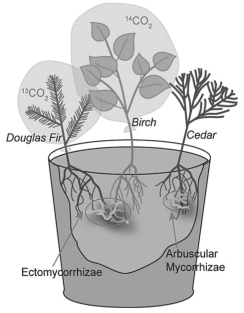Multiple Choice
Suzanne Simard and colleagues knew that the same mycorrhizal fungal species could colonize multiple types of trees. They wondered if the same fungal individual would colonize different trees, forming an underground network that potentially could transport carbon and nutrients from one tree to another (S. Simard et al. 1997. Net transfer of carbon between mycorrhizal tree species in the field. Nature 388:579-82) . Figure 31.2 illustrates the team's experimental setup. Pots containing seedlings of three different tree species were set up and grown under natural conditions for three years; two of the three species formed ectomycorrhizae (Douglas fir, birch) and the other (cedar) formed arbuscular mycorrhizae. For the experiment, the researchers placed airtight bags over the Douglas fir and birch seedlings; into each bag, they injected either carbon dioxide made from carbon-13 or carbon-14 (¹³CO₂ and ¹⁴CO₂, isotopes of carbon) . As the seedlings photosynthesized, the radioactive carbon dioxide was converted into radioactively labeled sugars that could be tracked and measured by the researchers.

Figure 31.2
-Referring to Simard et al.(1997) ,what is the result that would most strongly refute their hypothesis?
A) No movement;carbon-14 is found in the birch seedling's tissues and carbon-13 in the Douglas fir.
B) Reciprocal exchange;carbon-14 is found in the Douglas fir seedling's tissues and carbon-13 in the birch.
C) Either carbon-13 or carbon-14 is found in the fungal tissues.
D) Either carbon-13 or carbon-14 is found in the cedar seedling's tissues.
Correct Answer:

Verified
Correct Answer:
Verified
Q5: Why is it reasonable to hypothesize that
Q8: Why is it important that ectomycorrhizal fungi
Q14: Which of these fungal features supports the
Q15: Why are mycorrhizal fungi superior to plants
Q21: Basidiomycetes are the only fungal group capable
Q21: You are a forester charged with increasing
Q22: Looking at Figure 31.1,draw a new graph
Q23: Figure 31.5<br>Use the graphs in Figures 31.4
Q23: The fungi that we commonly know as
Q26: Use the following information when answering the